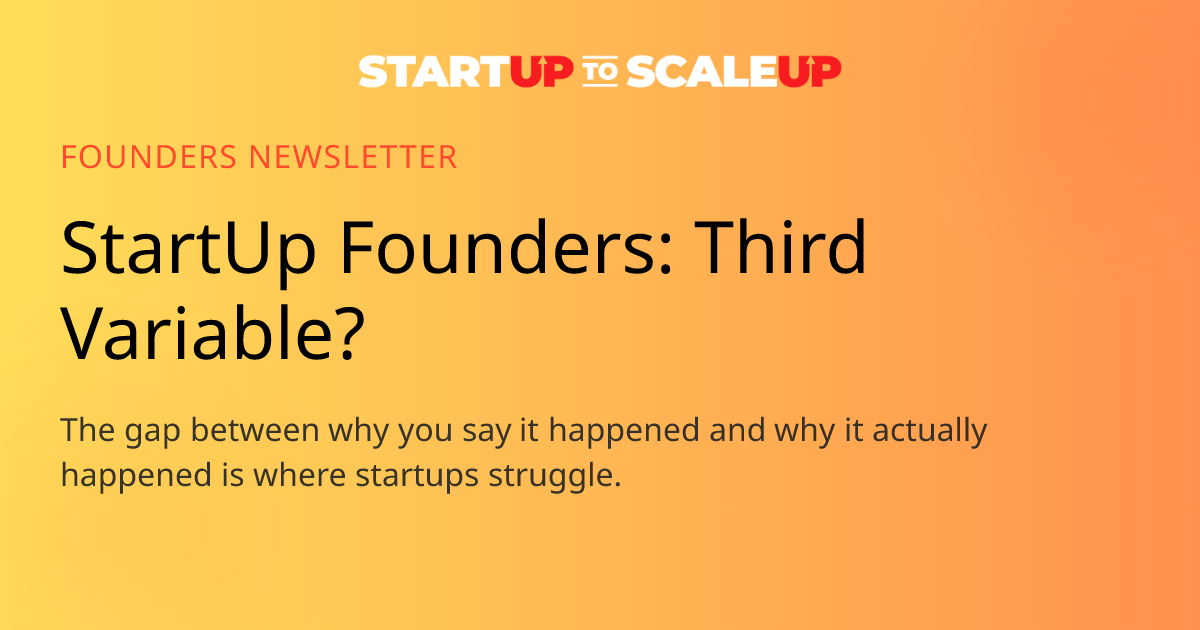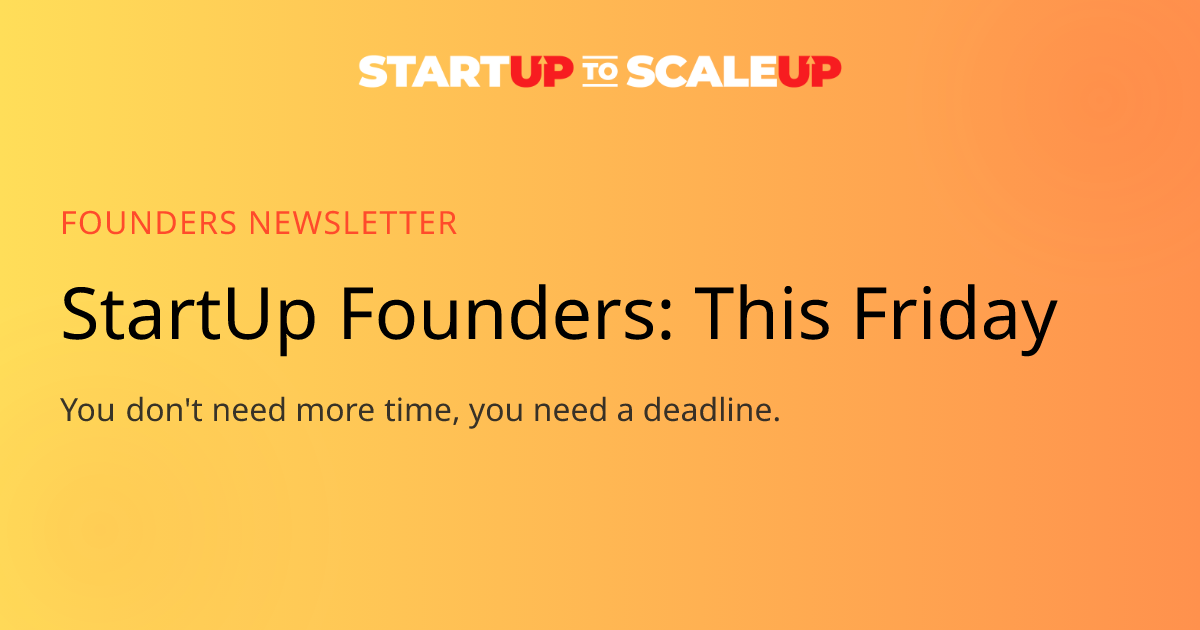SCARF UX Empathy: How to Audit Emotional Friction in Your Startup Funnel
Published June 21, 2025
Core Takeaway
TLDR
- Most users don’t bounce because of poor UI — they bounce because of violated emotional expectations.
- SCARF (Status, Certainty, Autonomy, Relatedness, Fairness) is your startup’s hidden UX checklist.
- Emotional friction kills perfect funnels. Do a SCARF audit on your own product and fix what the brain actually reacts to.
Newsletter
Hey Founder,
We need gamification!!
We need a checklist at signup, because users don’t like leaving jobs unfinished. That’s certainty. They want a clear path, closure, and to know what's next.
We need badges and progress markers, because users like feeling recognized. That’s status. They need to feel like they’re getting somewhere and that it matters.
We need customizable flows and smart defaults, because users don’t like being forced into decisions. That’s autonomy. Give them agency, or they’ll leave.
We need social proof and shared milestones, because users like knowing others are doing it too. That’s relatedness. People follow people.
We need transparent rules and fair outcomes, because users don’t like being tricked or cheated. That’s fairness. Hidden fees, unclear logic. Instant churn.
Gamification works not because it’s “fun” but because it regulates these five core reward/threat systems. You're not just optimizing for clicks. You're optimizing for the human brain.
I know this one’s a bit a tad academic, feels a bit preachy. But it matters. Because so much of what you’re trying to do comes down to one thing… How people feel. And I think this framework might help you think a little differently.
We all optimize our startup for output. Totally fair, makes sense, follows the playbook. Better onboarding. Better revenue. Better UI.
But what if you optimized for psychological inputs? People don’t buy, convert, refer, or stick around because of your funnel. They do it because something in their brain makes them feel safe. Seen. In control.
You can name it whatever you want. A user behavior issue, churn, friction, UX, you can take it one step further… If they would just try it, they would see how fab it is. But assuming you don’t have a non-solution to a non-problem that no one wants… It almost always maps back to a violated SCARF driver.
SCARF is a model developed by David Rock:
- Status: Am I valued here?
- Certainty: Do I know what’s coming next?
- Autonomy: Do I get to choose?
- Relatedness: Am I in this with others?
- Fairness: Am I being treated justly?
It’s the invisible OS of human motivation. When you align with it, it makes it easy for people to lean in. When you violate it? They don’t. Pretty binary.
I had this exact experience this weekend. Took my dog in for some shitty end-of-life moment. Usual place was closed, went to a 24/7 emergency vet.
They took my name, sent me a link to fill out forms (Certainty - good). But then they took my dog to the back and said it could be 20 minutes to 4 hours (Certainty - violation). Can’t give me my dog back while waiting (Autonomy - violation). Can’t give me any updates (Status - violation).
I’m sitting in a room full of other worried pet owners, all just staring at our phones (Relatedness - violation). My brain was in full freak-out mode the entire time.
It would have been so easy to make my experience better, but they don't need to. It’s an urgent care. It’s packed. I’ll probably go back in an emergency. So for them, the cost of SCARF violations didn’t exist. For me it did.
You don’t have the same luxury. It’s something you actually need to think about because you rarely see a SCARF violation in your Posthog recording…
Most of the time, you’re violating it without knowing.
Let me put this in context. You’ve built what looks like the cleanest flow to get your users to do the thing. Users drop in, move through the steps, but still don’t convert or they do but don’t stick.
You tweak. Add features. Tweak more. Nothing really changes. But what if it’s not the flow? What if it’s how the flow feels?
You tried to make it frictionless, the mandate of every UX podcast. But maybe you violated Autonomy by boxing them into a forced path (skip for now). Maybe you removed Certainty by not showing what comes next in the process. You forgot Status so users felt like inputs, not adored users. The product worked. But the experience didn’t.
You’re trying to manufacture outcomes but at the cost of how people feel while getting there.
That’s SCARF. That’s emotional friction. And it’s why a perfect funnel still fails.
This is the groundwork to empathy. Put yourself in your user’s shoes.
But not the fluff “think like your customer” empathy — this is neurological empathy. Understanding what their brain is actually doing when they interact with your product.
Most founders think empathy means caring about users. It does. But caring doesn’t tell you why they bounce at step 3 of onboarding. Caring doesn’t explain why your landing page doesn’t convert.
SCARF empathy does. Because it forces you to think like a brain, not a founder.
Here’s your SCARF audit:
- “What happens next?” (Certainty) — If they can’t answer this instantly, you’ve got uncertainty. They leave.
- “Am I doing this right?” (Status) — If they can’t tell if they’re winning or failing, you’ve got a status threat. They leave.
- “Do I have to do this their way?” (Autonomy) — If they feel trapped in your flow with no choices, you’ve got control issues. They leave.
- “Is anyone else here?” (Relatedness) — If they feel like the only person using your product, you’ve got isolation. They leave.
- “Are they being straight with me?” (Fairness) — If anything feels hidden or unfair, you’ve triggered their scam-o-meter. They leave.
Do this audit not on your analytics dash. Not delegated. You. In your actual product, thinking like your users think.
All of this to say that your users are emotional pattern machines. They’re not just optimizing for speed or outcomes. They’re constantly scanning every interaction and it’s doing one of two things:
- Reinforces safety + motivation
- Triggers uncertainty + withdrawal
So while most product advice ends with:
“Make it easier.” “Remove friction.” “Add delight.”
If you ignore human psych, you’ll keep building funnels that “should work” but don’t.
So maybe, just maybe, do the SCARF audit.
Do they feel certain? Do they feel progress? Do they feel in control? Do they feel connected? Do they feel respected?
If not? It doesn’t matter what you built. Because people don’t act on what they see. They act on how they feel.
If I can be of service, feel free to grab time.
LFG.
— James
Frequently Asked Questions
More Newsletters

Third Variable: Why Startup Founders Misattribute Causation and Miss Root Causes

This Friday: Why Startup Founders Need Deadlines, Not More Time

Forward Deployed Engineers: How Startup Founders Absorb Friction to Drive Customer Success
Continue Your Founder Journey
Explore all the resources available to help you build and scale your startup
Startup Frameworks Library
Subscribe to the Newsletter
Join 140,000+ founders getting exclusive strategies, frameworks, and founder stories every Sunday.
Get instant access to the 50-Step Founder Playbook downloaded over 1M times
